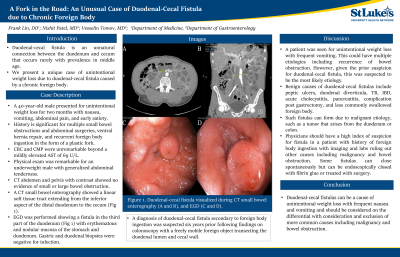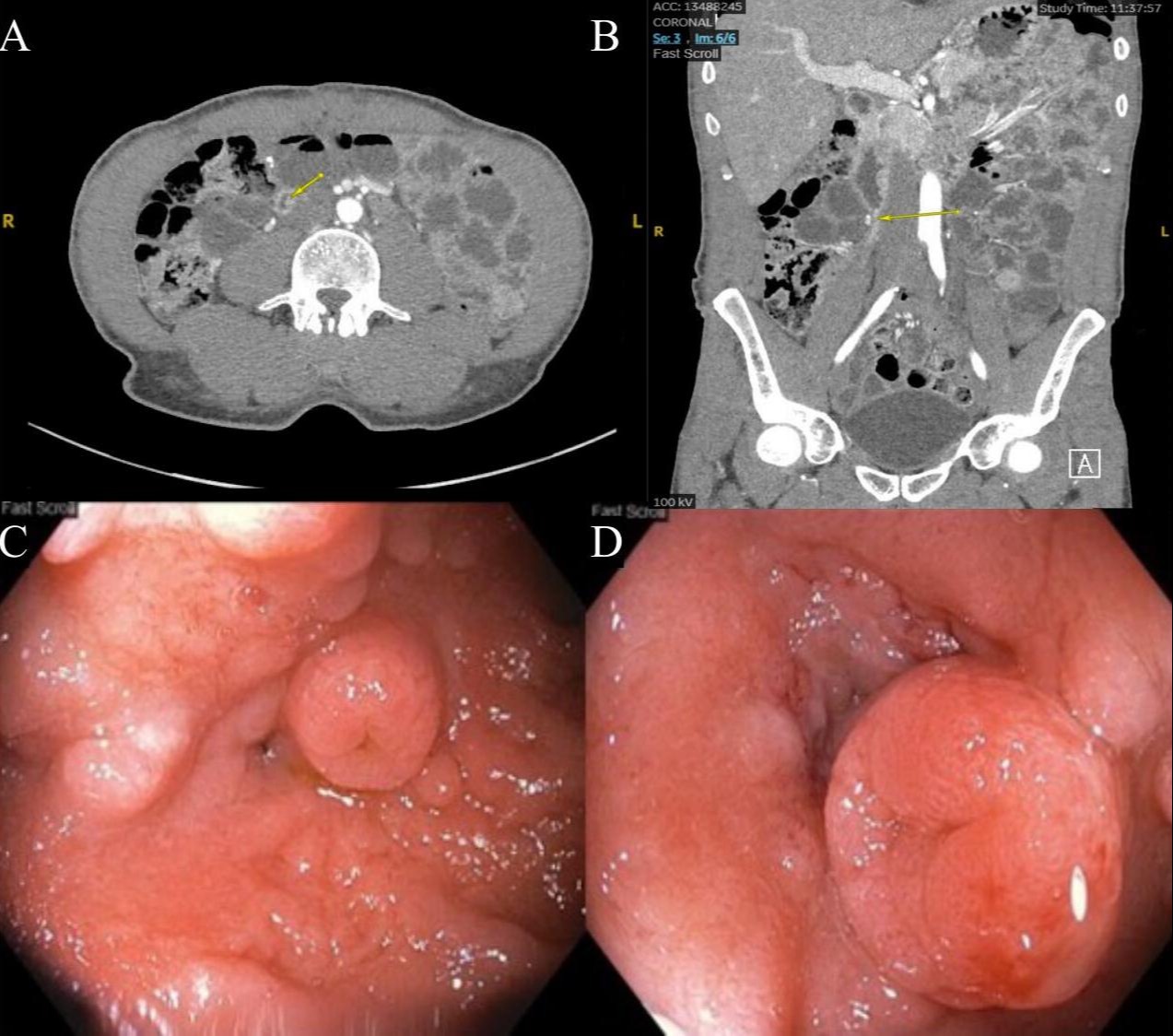Sunday Poster Session
Category: Small Intestine
P1310 - A Fork in the Road: An Unusual Case of Duodenal-Cecal Fistula Due to Chronic Foreign Body
Sunday, October 22, 2023
3:30 PM - 7:00 PM PT
Location: Exhibit Hall

Has Audio

Frank Lin, DO
St. Luke's University Health Network
Easton, PA
Presenting Author(s)
Frank Lin, DO1, Nishit Patel, MD2, Vesselin Tomov, MD3
1St. Luke's University Health Network, Easton, PA; 2St. Luke's University Health Network, Bethlehem, PA; 3St. Luke's University Health Network, Bethlehem, PA
Introduction: Duodenal-cecal fistula is an unnatural connection between the duodenum and cecum that occurs rarely with prevalence in middle age. Such fistulas can form due to benign or malignant etiology, such as a tumor that arises from the duodenum or colon. Other cases can be benign, such as peptic ulcers, duodenal diverticula, IBD, and more rarely foreign body ingestion. We present a unique case of unintentional weight loss due to duodenal-cecal fistula caused by a chronic foreign body.
Case Description/Methods: A 40 year old male presented for unintentional weight loss for two months with nausea, vomiting, abdominal pain, and early satiety. History is significant for multiple small bowel obstructions and abdominal surgeries, ventral hernia repair, and recurrent foreign body ingestion in the form of a plastic fork. CBC and CMP were unremarkable beyond a mildly elevated AST of 69 U/L. Physical exam was remarkable for an underweight male with generalized abdominal tenderness. CT abdomen and pelvis with contrast showed no evidence of small or large bowel obstruction. A CT small bowel enterography showed a linear soft tissue tract extending from the inferior aspect of the distal duodenum to the cecum (Fig 1). A diagnosis of duodenal-cecal fistula secondary to foreign body ingestion was suspected six years prior following findings on colonoscopy with a freely mobile foreign object transecting the duodenal lumen and cecal wall. EGD was performed showing a fistula in the third part of the duodenum (Fig 1) with erythematous and nodular mucosa of the stomach and duodenum. Gastric and duodenal biopsies were negative for infection. He was treated with PPI and sucralfate and scheduled for a follow-up upper GI series.
Discussion: This patient was seen for unintentional weight loss with frequent vomiting. This could have multiple etiologies including recurrence of bowel obstruction. However, given the prior suspicion for duodenal-cecal fistula, this was suspected to be the most likely etiology. Benign causes of duodenal-cecal fistulas include peptic ulcers, duodenal diverticula, TB, IBD, acute cholecystitis, pancreatitis, complication post gastrectomy, and less commonly swallowed foreign body. Physicians should have a high index of suspicion for fistula in a patient with history of foreign body ingestion with imaging and labs ruling out other causes including malignancy and bowel obstruction. Some fistulas are able to close spontaneously but can be endoscopically closed with fibrin glue or treated with surgery.

Disclosures:
Frank Lin, DO1, Nishit Patel, MD2, Vesselin Tomov, MD3. P1310 - A Fork in the Road: An Unusual Case of Duodenal-Cecal Fistula Due to Chronic Foreign Body, ACG 2023 Annual Scientific Meeting Abstracts. Vancouver, BC, Canada: American College of Gastroenterology.
1St. Luke's University Health Network, Easton, PA; 2St. Luke's University Health Network, Bethlehem, PA; 3St. Luke's University Health Network, Bethlehem, PA
Introduction: Duodenal-cecal fistula is an unnatural connection between the duodenum and cecum that occurs rarely with prevalence in middle age. Such fistulas can form due to benign or malignant etiology, such as a tumor that arises from the duodenum or colon. Other cases can be benign, such as peptic ulcers, duodenal diverticula, IBD, and more rarely foreign body ingestion. We present a unique case of unintentional weight loss due to duodenal-cecal fistula caused by a chronic foreign body.
Case Description/Methods: A 40 year old male presented for unintentional weight loss for two months with nausea, vomiting, abdominal pain, and early satiety. History is significant for multiple small bowel obstructions and abdominal surgeries, ventral hernia repair, and recurrent foreign body ingestion in the form of a plastic fork. CBC and CMP were unremarkable beyond a mildly elevated AST of 69 U/L. Physical exam was remarkable for an underweight male with generalized abdominal tenderness. CT abdomen and pelvis with contrast showed no evidence of small or large bowel obstruction. A CT small bowel enterography showed a linear soft tissue tract extending from the inferior aspect of the distal duodenum to the cecum (Fig 1). A diagnosis of duodenal-cecal fistula secondary to foreign body ingestion was suspected six years prior following findings on colonoscopy with a freely mobile foreign object transecting the duodenal lumen and cecal wall. EGD was performed showing a fistula in the third part of the duodenum (Fig 1) with erythematous and nodular mucosa of the stomach and duodenum. Gastric and duodenal biopsies were negative for infection. He was treated with PPI and sucralfate and scheduled for a follow-up upper GI series.
Discussion: This patient was seen for unintentional weight loss with frequent vomiting. This could have multiple etiologies including recurrence of bowel obstruction. However, given the prior suspicion for duodenal-cecal fistula, this was suspected to be the most likely etiology. Benign causes of duodenal-cecal fistulas include peptic ulcers, duodenal diverticula, TB, IBD, acute cholecystitis, pancreatitis, complication post gastrectomy, and less commonly swallowed foreign body. Physicians should have a high index of suspicion for fistula in a patient with history of foreign body ingestion with imaging and labs ruling out other causes including malignancy and bowel obstruction. Some fistulas are able to close spontaneously but can be endoscopically closed with fibrin glue or treated with surgery.

Figure: Duodenal-cecal fistula visualized during CT small bowel enterography (A and B), and EGD (C and D).
Disclosures:
Frank Lin indicated no relevant financial relationships.
Nishit Patel indicated no relevant financial relationships.
Vesselin Tomov indicated no relevant financial relationships.
Frank Lin, DO1, Nishit Patel, MD2, Vesselin Tomov, MD3. P1310 - A Fork in the Road: An Unusual Case of Duodenal-Cecal Fistula Due to Chronic Foreign Body, ACG 2023 Annual Scientific Meeting Abstracts. Vancouver, BC, Canada: American College of Gastroenterology.
